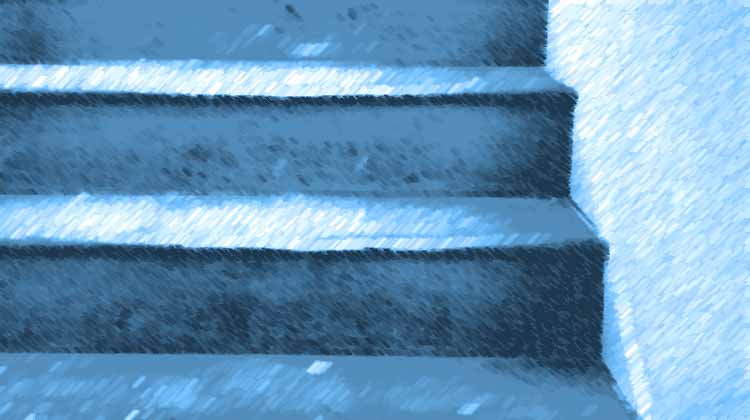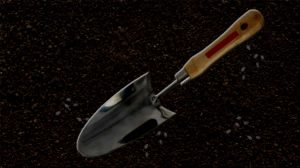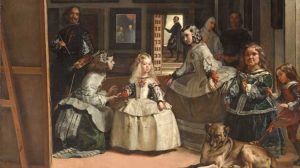
1.
On the fiftieth anniversary of the moon landing, this summer, I was thinking about my grandmother Esther, in Brooklyn, and how in 1969 her orbit was bingo, the flea market, Eighth Avenue. It was the little journey of her cigarette, that slender rocket ship, its tip glowing as she watched Neil Armstrong walk on the moon at the house on 56th Street. By then her mother’s bed was in the front parlor, her mother’s hair so long its ash-brown ends reached all the way back to Norway.
2.
In the photo my grandmother took, the TV is a blur in a dark room. One blob is the lunar lander, the other is the flag. She was fifty-four years old. I’ll be fifty-four myself soon, but when I was a child, she was the age a grandmother is. No one photographed her first steps in America. When the Bergensfjord docked at Ellis Island on June 18, 1916, Esther was Aasta, a Norwegian baby, one year, one month, and five days old the day she met her father.
3.
This is a story about emigration. Those steps, small, giant.
My grandmother’s family sojourned for several years in America, and returned to Norway when my grandmother’s older sister, Signe, contracted polio.
4.
And then something remarkable happened. In Norway, the child Aasta refused to speak Norwegian. She put her foot down—her small, stubborn, newly American foot. The second time the family left for New York, in 1924, she made it happen with her obstinacy. This fight over language was the story about my grandmother, the one that was always told. This story is about emigration, about the will to leave. In Brooklyn, when relatives visited in the 1940s and ’50s, they said, of the boy who would become my father, That’s Aasta’s son, meaning, Of course he doesn’t speak Norwegian.
Nevertheless my father, on his paper route in Brooklyn, delivered Nordisk Tidende.
These emigrations, when adults spoke of them in my childhood, seemed to have taken place a very long time ago, but those events were not so very long before my birth.
5.
New York was bigger than Norway, but Esther’s life got smaller, it seems to me, in those homes where she and Signe lived with their parents their whole lives. Her sailor ancestors had seen the world. They got their photographs taken in studios in the cities of the old Hanseatic League—Hamburg, Stralsund. They sailed to Arkhangelsk, in Russia, and Alexandria, Egypt, and Newport, Rhode Island. In Brooklyn the Olsens lived on 50th Street, and then on 56th. Esther got pregnant, which was a secret, at first, and then she had a baby, not a secret. The baby died, and then it was a secret again; a life that could have been a story was not. Later, Esther met and married Eddie, and my father was born.
Esther and Eddie went upstate to Lake Placid, and she sent a postcard to Signe: Lake Placid is a beautiful place. In the summer, she took my father to stay with cousins in Baltimore—less risk of polio there. We’re having a swell time.
6.
A wheelchair bore Signe through the house, through her life. On the Seventeenth of May, Norway’s Constitution Day, she wore a rosette with ribbons on the shoulder of her dress and sat queenly on the throne of her chair. Her clothes, smart and feminine, she made herself. Always, on her small feet, she wore lovely shoes with three-inch heels on which she could not stand. When she mashed potatoes, her strong arms held the pot steady on the arm of the chair.
7.
When we visited in the 1970s, I slept on a cot in the second-floor bedroom, and if I woke up in the night, I might hear pacing on the floor above me. Those steps—they were the sound of my grandmother’s insomnia, or her depression, or the echoes of her emigration. What kind of cigarettes did she smoke? I’d like to know that now, and the answers to some other questions that I have. Was it true that no one ever saw Signe go up and down the stairs? Did my great-grandmother really never cut her hair?
8.
In Bay Ridge and Sunset Park in the 1970s, the Seventeenth of May parade was still an act of emigration. We’d visit my grandparents, and we’d stand on the Norwegian American sidewalk and watch our culture floating past in red-white-and-blue. And we the children shared Eighth Avenue with the living and the dead. Back home in Virginia, after a five-hour drive in the Squareback, my father would place a person-to-person call and ask for someone who wasn’t there—someone who didn’t exist. That way, my grandmother would know we’d gotten back safely, and my father saved the expense of a long-distance call. The point was to connect without saying anything, which tells you everything you need to know about my father’s family.
9.
Some years ago, my phone rang, and on the other end of the line, a woman said, Walter Olsen wants to speak with you. Like an old-time operator, the caregiver connected me with my father’s last living uncle—somehow I’d obtained his address, in Vails Gate, near Newburgh, New York, and I’d mailed him some copies of family photos. Walter was confused in a way I was to see all too soon in my father; he asked me if I knew his sister. My sister Signe—that was what he said. Reader, she died before I was born. My reply to him is why I’ve written this essay now: to unsay what should not have been said. To say, Of course I know her.





Gregory K. Stephenson says
I enjoyed this enormously and was touched to read it.
Kit Nielson says
Erica, I enjoyed reading your essay. It pulled heartstrings about my grandmother and all I wish I would have asked her when I could have, but I was young, and just loved her and never thought about losing her.
Erica Olsen says
Thank you for reading this, Kit!
Mary says
Beautiful story. In answer to some questions: Uncle Steve said your great grandmother never cut her hair. Your grandmother smoked Philip Morris regulars. Love you, Aunt Mary
Erica Olsen says
I so appreciate these answers—and of course, there are always more questions!